#they were from like early 20th century so like 1910
Text
I’m not gonna smoke in an old ass graveyard again
#.txt#I pulled in and was like ‘wait how do I get outta here I don’t wanna reverse’#so I like pulled a 3 point turn and def rolled over some grave markers#they were just slabs in the ground so I didn’t like topple someone’s tombstone they were like potholes#but still#also made me think how weird graveyards are#like… you can’t move them#so there are these markers of where old towns were centered#graveyards for entire communities that don’t exist anymore#they were from like early 20th century so like 1910#and there’s this patch of land that looks like all the other graveyards#but the little details reveal how sprawling time really is#but how things stay so much the same….#like idk the idea of a final resting place kinda sunk in#cuz like yeah for more than 100 years now these people have been in the spot they were buried#and slowly it might get more lonely and the people who knew you and your family leave#but there’s this small group of strangers that you’ll be around the rest of eternity
1 note
·
View note
Note
i was rewatching the rite of spring segment from fantasia and i've got to wonder. Why Did We Draw Archaeopteryx Like That. i remember toys having that same, boomerang arm shaped pose too. it's like a monkey lizard more than a bird.
Ooh okay this is a fun one cause while it technically is an Archaeopteryx and is listed as such in the production draft, I don't think the design is based on Archaeopteryx at all!
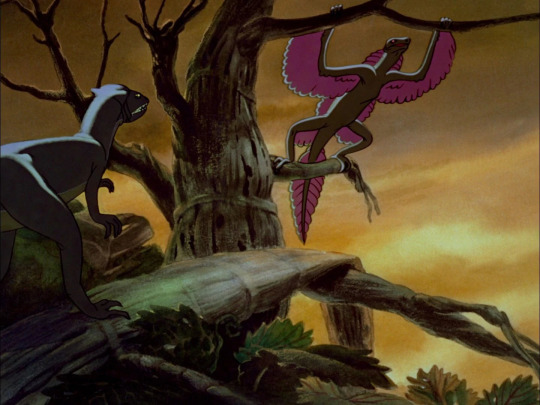
To me, this "Archaeopteryx" almost exactly resembles something else, the fascinating historical phenomenon called Proavis.
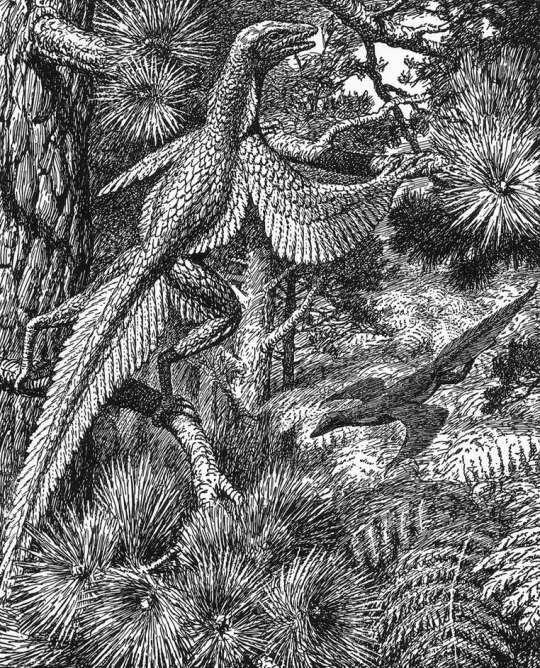
Proavis, or Tetrapteryx as some four-winged interpretations were called, was a hypothetical prehistoric creature that was proposed in the early 20th century as a best guess at what the unknown ancestor of birds could have looked like. The illustration above was drawn in 1926 by Gerhard Heilmann, a Danish artist and amateur scientist who argued that birds evolved from non-dinosaurian archosaurs like Euparkeria. In his 1916 book Vor Nuvaerende Viden om Fuglenes Afstamning and the 1926 English translation The Origin of Birds, he presented Proavis as the imagined midpoint between a scaly ground-running archosaur and Archaeopteryx, which at the time held the title of The First Bird.

Other versions of the same hypothesis, like William Beebe's Tetrapteryx above, were published and discussed around the same time, but it was Heilmann's Proavis that gained immense popularity to the point that bird evolution was considered essentially "solved" for decades. It was also painted by Zdeněk Burian, one of the Old Greats of palaeoart, which kept the concept alive in dinosaur books for decades as well.

Of course further study has shown this hypothesis to be incorrect and that birds are instead members of Dinosauria (and honestly Heilmann either missed or ignored a lot of evidence for a dinosaurian origin of birds even in the 1910s), but the Proavis to me remains a beautiful and fascinating concept that represents scientists and artists striving to understand the prehistoric world and the passage of evolution, much like we still do today!
And of course, its popularity in the early 20th century put it at the perfect time for Fantasia's artists to take... let's say heavy inspiration from Heilmann's imaginary Proavis when depicting a creature that was intended to be Archaeopteryx the whole time! The pattern of feathers matches up almost exactly, although the larger leg wings might have been inspired by Beebe's Tetrapteryx as well:
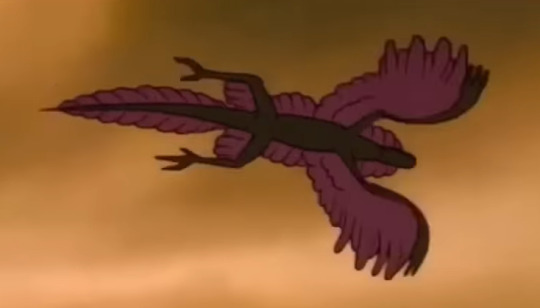
So to get back to your original question that led to this whole deep dive, artists didn't actually Draw Archaeopteryx Like That except when they were mistakenly drawing something that wasn't Archaeopteryx at all! If you want to read more about the Proavis and Tetrapteryx I recommend this Tetrapod Zoology blog post by Darren Naish, he does into more depth about the history of the concept and some of the unusual evolutionary ideas that Heilmann used to arrive at this weird and cool imaginary creature!
798 notes
·
View notes
Text
LGBT literature of the 1860s–1910s. Part 5
After a long pause, the list is back! Here we have a couple of plays, accounts by two trans women, lesbian poetry, and more.
1. Despised and Rejected, by A.T. Fitzroy (Rose Allatini; 1918). A pacifist novel published during World War One? With gay and lesbian characters? Yes, that was sure to get people in trouble. Its publisher was fined and the judge called it “morally unhealthy and most pernicious”. So, Dennis is a young composer who hates violence and therefore refuses to go to war. He also suffers because he is a “musical man”, that is, gay, and loves Alan, art-loving son of a wealthy businessman. His friend Antoinette, meanwhile, is “strangely attracted” to a woman. Nevertheless, the two attempt to love each other. When the war begins, Alan appears in Dennis’ life again, and they try to avoid being sent to the front together. Alan also persuades Dennis to accept who he is. Edward Carpenter himself defended the novel, saying that “the book is also a plea for toleration of a very much misunderstood section of humanity”.
Read online
2. Autobiography of an Androgyne, by Ralph Werther (1918). Ralph Werther, also known as Jennie June, wrote this autobiography for doctors, and it is very revealing. Being a New York fairy (male prostitute) and possibly a trans woman, they tell frankly about the city’s gay underworld of the early 20th century and their personal experience, which is sometimes too frank and dark perhaps, but all the more interesting.
Read online
3. Poems by Mikhail Kuzmin. Kuzmin was not just the author of Russia’s first gay novel, but also a poet. Many of his works were dedicated to or mentioned his lovers. I’d recommend Where Will I Find Words (in English and Russian), Night Was Done (both in English and Russian), from the 1906-1907 collection Love of This Summer (available fully in Russian), mostly based on his love affair with Pavel Maslov in 1906. And also If They Say (in English and Russian), which is a great statement.
4. The Loom of Youth, by Alec Waugh (1917). A semi-biographical novel based on Evelyn Waugh’s older brother’s experience at Sherborne School in Dorset. It is a story of Gordon Caruthers’ school years, from the age of 13 to 19, and it is full of different stories typical for public schools, be it pranks and cheating exams or dorm life and sports. Although the homosexual subject was quite understated, the author implied that it was a tradition and open secret in public schools. The book became popular and soon caused a great scandal. Worth noting that before that Alec was expelled for flirting with a boy.
Read online
5. Two Speak Together, by Amy Lowell (1919). Lowell was a famous American poet and lesbian. Many of her poems were dedicated to her lover, actress Ada Dwyer Russell, specifically the section Two Speak Together from Pictures of the Floating World. These poems are infused with flower imagery, which wasn’t uncommon for lesbian poetry of the time.
Read online
6. De berg van licht/The Mountain of Light, by Louis Couperus (1905-1906). Couperus is called the Dutch Oscar Wilde for a reason: this is one of the first decadent novels in Dutch literature. It is also a historical one, telling about a young androgynous Syrian priest Heliogabalus who then becomes a Roman Emperor. Homoerotism, hedonism, aestheticism: Couperus creates a very vivid world of Ancient Rome. He also covered the topic of androgyny in his novel Noodlot, which was mentioned in Part 3 of this list.
Read online in Dutch
7. Frühlings Erwachen/Spring Awakening/The Awakening of Spring, by Frank Wedekind (1891, first performed in 1906). This play criticized the sexually oppressive culture prevalent in Europe at the time through a collection of monologues and short scenes about several troubled teens. Each one of them struggles with their puberty, which often leads to a tragic end. Like in The Loom of Youth, homosexuality is not the central focus of the play, but one character, Hänschen, is homosexual and explores his sexuality through Shakespear and paintings. The play was later turned into a famous musical.
Read online in German or in English
8. Twixt Earth and Stars, by Radclyffe Hall (1906). Though it wasn’t known to many at the time, these poems were dedicated to women, some to Hall’s actual lovers.
Read online
9. The Secret Confessions of a Parisian: The Countess, 1850-1871, by Arthur Berloget (published in 1895). This account is similar to the Autobiography of an Androgyne, albeit shorter. The author nowadays is thought to be a trans woman. They describe their love for women’s dresses, the euphoria from wearing dresses, makeup and wigs, the life as a “female impersonator” in Parisian cafe-concerts, and their love affair with a fellow prisoner. The autobiography is not available online, but you can read it in Queer Lives: Men’s Autobiographies from Nineteenth-Century France by William Peniston and Nancy Erber.
10. At Saint Judas’s, by Henry Blake Fuller (1896). This is possibly the first American play about homosexuality. It is very short. An excited groom is waiting for his wedding ceremony in the company of his gloomy best man. They are former lovers, and this short scene is not going to end well…
Read online
Previous part is here
#lgbt literature#lgbt fiction#queer history#queer fiction#lesbian literature#russian literature#gay literature#gay history#spring awakening#lesbian history#blog: history#blog: literature
318 notes
·
View notes
Text
one of the few good faith questions about s1 gender roles is why louis is only paralleled with white women. why does the show make him iolanta, melisande, nora helmer, etc and not claire kendry or janie crawford, characters who also appear in literature from the show's time period. why is he reading flaubert, colette, edward carpenter and not claude mckay or nella larsen who actually writes a lot about interractial relationships. on one hand the showrunner is white and maybe those are the texts he feels most comfortable with, but there are more than a few black creatives working on the show who are contributing in significant ways.
first of all, characters like iolanta, stella kowalski and nora helmer do not need to be white. they are white in their original forms because the writers were white and sometimes based them on real people. tenessee williams always wanted to have streetcar performed by diverse casts even though he based the characters partly on people in his own family. many productions now have non-white actresses in these roles (assad zaman was in one of these productions of a doll's house). also we can safely say lestat assigns melisande to louis because that's the kind of shit he's into (french opera based on a belgian story) and he's not really well read.
beyond that though, to me the reason louis is paralleled with white women is because he's married to a white man in 1910 louisiana where not only was interracial marriage illegal but homosexual relations and even interractial cohabitation were banned. but because of lestat's power, money and their vampire powers, these roles don't really apply to them. people who were in interracial or homosexual relationships in the 1910s had very different struggles and conflicts from loustat, like most of them could barely step outside without worrying about their safety. they certainly wouldn't be parading around society together all the time while even the politicians and authorities know about their relationship. so how do you make sense of your marriage if its very existence is anachronistic?? who's writing about your experiences if your experience is such an outlier in your society literally due to supernatural forces? there's no shortage of black literature in this time period (which overlaps with the harlem renaissance!) but being married to a white man is quite fundamentally different to being married to a non-white man especially in early 20th century. a white man has complete control over his dominion which includes the home and the outside world. a non-white man may have control over his home but the minute he steps out the door he's at the mercy of white men, he could be killed for simply looking at someone the wrong way, which makes non-white men impossible to relate to lestat. and who was allowed to be married to white men in those days? white women.
and ultimately louis is nora because the conflict of needing to escape an overbearing husband was something allowed only to white women in literature/theater. the reason we find so many parallels between louis and white female characters like belle even now is because his role in this story is largely reserved for white women and this has clearly ruffled a lot of feathers because its unfamiliar. i'll be curious to see what the show does as time moves forward but for season 1 it's very clear to me why the show chose these specific intertextual references.
#the loumand dynamic in s2 intrigues so much for this reason#cause we are moving into a lot more liberated territory#for louis who is so well read especially how does he relate his story to the stories he's read#iwtv
92 notes
·
View notes
Text
Ling's life before FMA started is pretty vague, but there's things we can assume based on China's influence on the creation of Xing. FMA takes place in the early 20th century, probably sround 1910s to 1930s. The country Xing was based on, China, was at that time a revolt by a group of revolutionaries against the Qing Dynasty. The imperial system was ended, and put in its place was the Republic of China.
However, FMA follows a history where the Dynasty continued. So, what exactly is the Imperial system?
Chinese society was split into five categories, or classes, which were Nobility and the "four occupations." The highest class was Shi, or the gentry, then the Nong, farmers, Gong, craftspeople, and Shang, the Merchants.
Farmers were the base of China's economy and viewed as vital to their country. They provided cotton, food, and silk, along with many other consumeable goods. A large portion of the food they harvested went to Landlords, local Nobles, or was given out to the empire itself. Farming communities produced goods needed by the government, and if not, they were conscripted for public projects.
As a result of the massive area and amount of people, direct rule from the Emperor was not possible. The Emperor relied on civil servants to carry out his orders, most of which were members of the gentry. What was important to this class was literacy, since the Chinese government basically ran on paperwork. Both the nobles and Shi did not perform manual labor but could become painters and poets.
Laws and punishments were harsh to maintain power for the upper classes. A crime could lead to a criminal's entire family being executed. Their society was based on Confucian Principles, so it was the people in power's duty to lead the people well. ("While people should obey their rulers, the rulers should work to benefit their people."). The family structure was meant to have each member treat all the others with a mutual respect for their contributions to the family.
That same ideal applied to the family, where male heads were supposed to "govern wisely," and the rest of the house should obey. Women were expected to be subservient, and there had been only one female empress. Noble women were often involved with power struggles, but they worked mostly out of sight.
Because of these values, the more powerful a man was, the more likely he was to have many concubines besides his wife.
(Now I can talk about one of my favorite guys....😼😼😼)
Ling was probably one of the many sons caused by the Emperor having many concubines. Since he was probably an imperial concubine's son, Ling most likely had a very isolated life where he was forever fighting for his father's approval. Noble, or gentry classes, are filled with much cutthroat, inner fighting, where Ling's half siblings almost absolutely had attempts made on his life by assassins or tried to destroy his reputation.
At first, Ling seems to be laid back and carefree, but he actually takes his position as a prince very seriously. He tells Mei Chang that when he becomes Emperor, he is going to reunite their families and protect them. Ling has prioritized Lan Fan's and Ed's lives over his own, despite Ed having a lower status than him and Lan Fan being his body guard.
He is absolutely prepared to die for his cause. For his whole life, he has been completely aware that any one of his many half siblings could take his place, undo all his progress, and send him back to nothing.
The drive that he has led him through the desert, making the long, grueling joirney to Amestris. Since the people of Amestris don't know of his social status, he is able to act like a normal kid his age for once and become friends with Ed.
If anything is wrong, please let me know !!! ( ゚ε゚;)
Sources:
https://history.state.gov/milestones/1899-1913/chinese-rev#:~:text=In%10October%20of%201911%2C%20a.and%20ending%20the%20imperial%20system
https://www.unm.edu/~toh/china/age-of-empire.html#:~text=Tye%20Structure%20of%20Empire.%2C%20and%20shang%20(merchants)
#ling yao#ling fma#fma 03#fmab#fma ling#xing fma#fullmetal alchemist brotherhood#fullmetal alchemist
27 notes
·
View notes
Note
hi im trying to learn more abt north korean refugees from the korean war or more generally conditions in north korea during the war and its been like...rly challenging to find resources since the search engines will conflate them with defectors and what resources i do find tend to be "there were north koreans refugees. there were alot...a lot of them died...some did not" and not about why they fled or what was happening in north kroea at the time. i can make inferences from what i do know, but i was wondering if you had any resources or recommendations on where i could look since ive found ur dprk resources super informative & helpful in the past!
hello!
during the war, there was not yet a concept of a korean person being from the north or the south and that's probably a reason why you can't find specific resources if you're searching in that direction. generally, refugees fled to manchuria, china, russia, and japan. they tried to farm in these regions, tried to become educated and learn skills and crafts, and/or were part of anticolonial organizing efforts. the migrations to these areas began much before the war and there were sizable korean populations in these regions as early as the late 1800s and the 1910s.
a notable example is find very interesting is that there were enough communist koreans in russia and climbing the political ranks of the government at the beginning of the 20th century that in 1937, stalin had every korean person rounded up and sent to central asia (kazakhstan, uzbekistan, etc) under suspicion of them being japanese spies. which i personally think inspired the US to create japanese internment camps.
my understanding is that the borders to manchuria and china were not heavily enforced before the war and military occupation of the area so it was very common for people in the northern areas of the korean peninsula to travel back and forth for trade and live across the border for agricultural conditions.
for wartime conditions in the region, the northern half of the peninsula was bombed more severely than the southern half and the southernmost tip of the land is the only area where the trees on mountains are the original ones and not newly planted after the war (usually by the park chunghee administration). agriculture is more difficult in the north because of the terrain and the majority of the flat and fertile farming soil is in the jeolla province so the north was more likely to develop communist style industry, so the U.S. focused on flattening any man made infrastructure in the area. many people fled across borders and many people hid in caves in the mountains because the peninsula is very mountainous with many caves. for resources, i don't have anything more specific than what's already in my dprk tag! check the dprk study guide for further reading.
overall, many people fled korea from the late 1800s to after the war in the 1950s because of japanese labor exploitation and cultural persecution, artificially produced famine conditions because of japanese resource exploitation and then the effect of the U.S. bombings on the environment, and the sheer death and destruction of the bombings and ground military troops.
hope this is helpful and lmk if u have more specific questions i can answer!
23 notes
·
View notes
Text

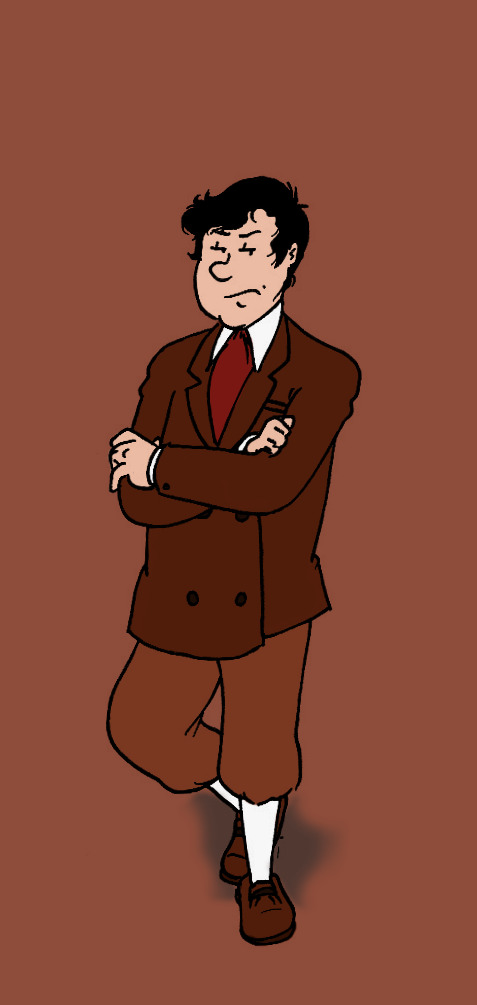




Inspired by @professorcalculusstanaccount's timeline posts, it's Roberto Rastapopoulos through the years! No little Greek boy don't grow up to be a massive shithead--
Rasta is a very difficult character to understand in canon, because so much of his lore is left unknown to the viewer. However, there were little bits and pieces, some in Herge's tertiary studio notes; over time I've wrung some water from that stone, and put together this timeline in my head. I went with a more condensed range than ProfCal (i.e. pre-canon up to canon, rather than into post-canon), since Rob does technically "die"/disappear by the end of the (finished) comics.
Headcanons and details under the cut:
According to speculative official notes, he was born in the 1890s in Leros. It's a beautiful island but also one with a turbulent history, as when little Roberto was born, that part of Greece was under control by the Ottoman Empire. His father was a sponge diver, which was a very viable career at the time. (Decades later, the industry would be ruined when the area's sea sponges were over-harvested by bigger diving operations.) His mother is basically unknown...many official outlets say Rastapopoulos is part American, so I imagine his mother was of Greek-American heritage who either met his father abroad or in America.
There were two real-world figures who influenced my timeline: Aristote Onassis and Aleister Crowley. Onassis was one of Herge's later inspirations when writing Rastapopoulos, and for good reason; much like Rastapopoulos's own immoral dealings, Onassis indiscriminately sold warships during WWII and can easily be considered an arms dealer who profited off of human atrocities. On the other hand, Aleister Crowley was my own connection. All the pseudo-Egyptian mysticism in Cigars of the Pharaoh and the Kih-Oskh Brotherhood seems to be a reference to the very real trend in the early 20th Century where the upper crust of western society became fascinated with esoteric beliefs. (Seances and the Ouija Board were also created during this era.) Crowley rose in infamy during this time, too, as a spoiled debutante who spent his inheritance on journeys through the MENA region to perform rituals and "adapt" Eastern religions for his own belief system. With Rastapopoulos making up an entire pharaoh and emblem for his secret trafficking club, it reminded me very much of Crowley's own endeavours, and the commodification of MENA cultures and iconography during this era.
Child (1897) - Canonically, he has three brothers and two sisters, so l envisioned him as the middle child amidst all that. Little Roberto was spoiled when he was little, but when his youngest brother was born, it left Roberto feeling like the attention had been stolen from him.
15 (1906)- The other siblings hoped Roberto would be just as enthusiastic as they were about the family diving business, but alas, he'd always been more interested in reading prose and classical plays. His favourite play is Gounod's Faust. Some days, he daydreams about what a deal with the devil could get him, thinking he'd be able to outsmart the devil and win his riches for free.
Roberto was at a rebellious point in his life, and sadly, he'd come to be ashamed of his background, deciding sponge diving was "peasant work" and that he'd rather tell others he was British or American. Eventually, it became easier for the whole family to just send him to a boarding school. Deep down, Roberto's parents hoped he might become an actor, a writer, or some sort of scholar...but the night before he left, Roberto secretly took down his whole family's banking information.
20s (1910s) - Roberto is now in his "Aleister Crowley's world tour" phase. He throws around mysteriously large quantities of money, often putting it into investments, and taking many journeys through Egypt and India. (I also like to imagine he met the Fakir and Colonel Fuad around this time; maybe Zloty too). Rastapopoulos is an insufferable, preening dandy at this time, trying to carve out his own place among the societal elite. His Greek identity is only flaunted as a way to make him seem more "exotic" to strangers. He tries not to think about the bank accounts he's leeching from.
30s (1920s) - Several of his investments actually flourished. His shares in Arab-Air and Flor Fina yield enough profit to let him buy out the companies, and his decadence only increases as he reaps even more profits. With extra money going around, Rastapopoulos finally decides to foray into the movie industry...as a movie producer. His passion for theatre never died, and if he can't become an actor himself, then why not produce the kinds of stories he wanted to be in?
By the time the Great Depression hits, Rastapopoulos has amassed more than enough wealth to stay afloat...and the drug ring he's started with a few good friends sure helps, too. He's more concerned with holding onto every millimetre of his receding hairline.
40s (canon) - By all means, Rastapopoulos could have disbanded the cartel and retired comfortably. Maybe he could have invested more in his own movies, and focused more on Cosmos Pictures's internal operations. And yet, he didn't. Bigger numbers are better, so Rastapopoulos kept amassing his dirty money, thinking he was too big to fall. He got messy and left behind some viable clues, which some Belgian kid happened to stumble across...
50s (1940s-early 50s)- "Roberto Rastapopoulos" may be out on bail and facing decades in prison, but "Marquis Dante di Gorgonzola" is just some mysterious financier with an offshore bank account. Some of the other societal elites recognize him, but they find the alter ego funny and play along; "Oh, here comes "the marquis"...! He's due back in Hong Kong!" He can't make money through drug trafficking anymore, he can't show his face in Hollywood, and he certainly can't go back to Greece. Unfortunately, some of his associates introduce him to a different kind of trafficking, one even more immoral, but just as lucrative...
It's the climax of the Rastapopoulos family tragedy: the son of hard-working commoners has ground his family's name into dust thanks to his pursuit of power and decadence; he has now resorted to deceiving those same sorts of commoners, dooming them to unknown fates just so he can buy a boat. Later, he begins resorting to harebrained schemes and petty crime just to maintain that lifestyle. His Greek identity has long been buried in favour of a vague, exotic cultural identity meant to explain away his quirks and twitchiness.
I've long been torn on whether or not Endaddine Akass is Rastapopoulos's final form. Herge's notes do consider him surviving Flight 714 to Sydney by waking up in the tropics with some degree of amnesia...perhaps this is near Jamaica, where he'll meet Ramo Nash under a new identity. It also feels the most theatrical - Rastapopoulos is playing yet another role, and he has a grand finale planned for Tintin's murder. Additionally, the mysticism Akass totes in Alph-Art is inspired by the alternative religion fads of the 1960s-70s; Akass is evocative of some of those many cult leaders, like Bhagwan Shree Rajneesh or Father Yod.
And yet, I almost find it more fitting for Rastapopoulos to survive Flight 714 to Sydney with full amnesia. He only knows himself as some middle-aged vagrant, and he decides he just has to pick himself up, and find some odd jobs to make a living. He gives himself a new name; his family history has been wiped clean. He struggles to make ends meet, much like the family he bankrupted, though he'll never know just how ironic his life has become. The rest of the world knows Rastapopoulos as a bombastic, flashy debutante who died a pitiful death during a police standoff. Tintin feels like he saw him one last time, but it feels like a bad dream he had during a flight layover. The man who always wanted to be the biggest and best died quietly in the sea, his true fate unknown, his body forever missing.
I think that's why I find Rastapopoulos so fascinating as a character! You can either make him into Tintin's greatest scourge who fights to the death to maintain his status, or you can rip all that away and doom him to a humble existence.
50 notes
·
View notes
Text
I'm still back on "The Flower of Utah" in Letters from Watson, so let's do some early Utah houses, thanks to Wikimedia Commons.
Here's one of the two surviving cabins from the first LDS settlers, built in 1847. This one belonged to Osmyn and Mary Deuel. John Ferrier's initial cabin would have looked a lot like this.

The idea that settlers would just expand the cabin, rather than building a fresh impressive house, is very different from my experience of settlement sites in the midwestern and western states, so I think Doyle was making up what he liked the sound of.
Building something like the Clark-Taylor house (1855-ish) seems more likely.

How Ferrier worked his land so effectively with no help from wives or children is a mystery. We'd have to be eliding some form of itinerant labor from young white men or natives passing through, or else he's hiring other people's excess children -- or it's just a handwave that Ferrier is just that much hard-working and resourceful. The plot requires Ferrier to prosper so that there can be a rich inheritance for Lucy.
Ah, Lucy! She's a standard-issue Spunky Western Girl, frequently seen in literature of the 1910s-1950s. Honest-spoken, brilliant on a horse, capable as a man but imbued with maidenly modesty -- she's a type. I'm surprised to encounter her in a story written in the 1880s, but most of my exposure is from when I lived in Arizona, which only became a state in 1912. Lucy is definitely a participant in the Victorian-era belief (not universal, but having strong outbreaks from time to time) that fresh air, exercise, and frontier society were better for health than stuffy drawing rooms.
If it's been 12 years (based on Ferrier's rise to wealth), then it's 1859 and Lucy is about 17, or (in the norms of the time) right at a liminal state of being ready for a push to leave the innocence of girlhood for the responsibilities of womanhood. The push to do so doesn't, narratively, have to be a man -- it can be a hardship, a loss, or other trial. But here comes Jefferson Hope!
Hope is here to raise money for silver mining in Nevada, which started its silver rush a year earlier with discovery of the Comstock Lode. The hard-faced, dark adventurer who entertains the maiden with his stories is also a trope of the era, one that really takes off in the 20th century, where it becomes an impetus for the girl to seek out adventure, too.
Hope and Lucy are engaged, all is well -- except, of course, we know it isn't. Polygamy still hasn't come up! Where are Lucy's other suitors? Surely the Flower of Utah had some!
19 notes
·
View notes
Note
I’m writing a little research paper on ep and one of my main points is his influence on 60s counterculture so i was wondering how u think he affected the decade since u seem to know a lot ab that time !!
Oh wow, I am sooo behind on asks but I couldn't resist this - can I ask if this is for a class or for fun? Elvis was sort of a pioneer of 1950s rock hipster counter culture, but even then, it's hard to suggest Elvis had a one-way influence on counterculture in the in the 1950s or 60s, but rather, that he engaged and changed it, popularizing in the 1950s a sort of androgynous sexuality and style, and breaking the color line by incorporating the Black Southern culture he grew up in into his music and mixing it with country and blue grass, creating a racial hybridity that really reflected where he was from. He had a lot of privilege to do this as a white performer, but also we cannot discount how Elvis' engagement and history in Black spaces, culture and his collaboration with Black writers and musicians violated segregation norms and upset a lot of the white supremacists in the South.
As for the 1960s, there is his legacy in rock and roll and pushing the boundaries of musical expression, sexual and gender norms, and youth culture that I think really impacted the 1960s counterculture's slang, fashion and music and style, not just from his 1950s work but also from his performances in films and coverage of him in the press. His style reflected and influenced all the different counterculture movements of the 1960s, the beatniks, the mods and later psychedelia and hippie culture. He was also a student of alternative spiritualism schools, read a lot of books on different spiritual pursuits and was very involved with the Self-Realization Fellowship in Pacific Palisades (a corner of LA between Santa Monica and Malibu).
Big figures of 1960s counterculture, such as John Lennon, Bob Dylan Simon & Garfunkel and Jim Morrison have all said they were deeply influenced by Elvis, and they were all about 15 years old when he became a big deal in the late 1950s, so I don't think we can underestimate his important influence on them at that stage of their creative taste and development. If you look up early Beatles photos they were all essentially cosplaying as Elvis.... and Bob Dylan talks about Elvis' influence on him in his most recent book.
I recently heard an interview with the author of this book and she makes the argument that Elvis' fashion involved performers like David Bowie and Harry Styles...
Then there is just the recognition and valuing of youth culture in general, and female pleasure, through his films, which were the most visible way people interacted with Elvis in the 1960s, and I think many cultural critics used the way his films appealed to youth and female youth specifically to denigrate him but I think we should exult this, because I love romantic comedy musicals and I hate that they were/are not taken as seriously as films like Beckett because I would argue just as much creative work can go into them.
And of course this brings me to sex! My favorite topic....A lot of people think of the 1950s as a time of conservative sexual politics but this just isn't the case, ask the flappers! I think we can probably trace the popularization of liberated women and sexual politics back to the first wave movement (liberated women have existed as long as time itself.... but it became much more socially acceptable during the 1910s and 20s). And its no accident the suffragate movement happened at the same time women began working in pink collar jobs in droves in the 1890s and after, and when we started to share popular culture through film (precode Hollywood was all SEX) and radio and lots of other historical changes that took place in the 1910s and 20s. If you are interested in female sexuality from a historical perspectiver this book is good.. i started reading t when i started writing fic that took place in the 1960s... but it is also something i was interested in....
I think Elvis' appeal to and the way he very visibly valued female fans and also made visible female sexuality is really really important to the sexual revolution of the 1960s. I think this, along with the way his music and style was very much culturally hybrid between Black and white southern music and the fact that he came from such a poor background was what really scared conservatives and elites. Greil Marcus has talked about how Elvis brought out the racial fears of a lot of people...
I haven't even gotten to the 1968 Singer Presents Elvis (often called the Comeback special but I am a crazy person and it was officially Singer Presents Elvis.... #tv history )
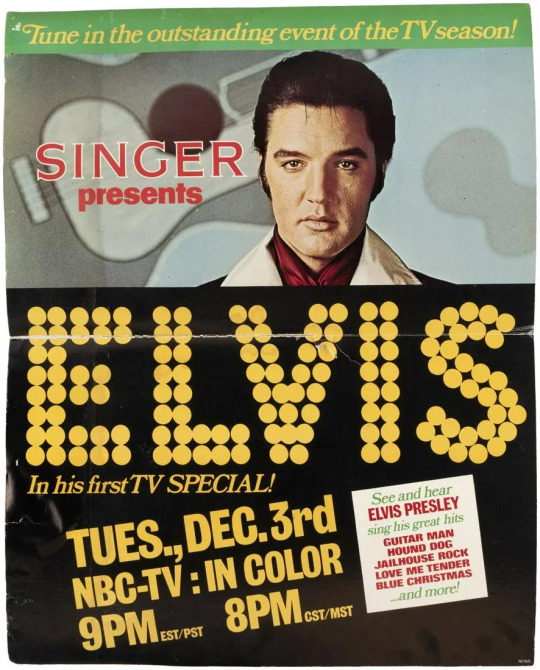
And the way this tv show both reflected and rearticulated social issues like the Civil Rights movement and women's lib... would Elvis say he was pro women's lib? No, but a lot of men at that time might have said one thing, while regularly working with and supporting and dating working women who were clearly at the very least benefiting from women's lib....
This is only the garbled mutterings of a sad history nerd.... I haven't really studied Elvis in an organized way, only as a hobby... but i'm tagging some of the other people on here who I've seen discuss this or who are smart @loving-elvis @missmaywemeetagain @whositmcwhatsit to see what they have to say..... and anyone else who wants to comment should!!!
And we're just not gonna get into his anti- hippie, pro Nixon stance in the 1970s because 15 years on speed makes you do questionable things....
42 notes
·
View notes
Text
A queer Oz
Oz is queer. There is no denying it. The land of Oz, the world of Oz has been embraced by gay and lesbians and was included as part of the LGBT community long before this acronym even appeared. Oz-related medias have shaped the homosexual communities, and there is no better way to prove it than to point out a common term most people know by now… FOD. “Friend of Dorothy”, an expression to designate a gay man and was used very often in the second half of the 20th century in Northern America to speak of homosexuality while avoiding any of the nasty side-effects these kinds of talks could have in this time. It isn’t used much anymore, thanks to LGBT communities becoming much more open, known and accepted in more times, but it still was a very important part of gay culture and history, and a clear mark tying it all to the world of Oz, and the character of Dorothy Gale.
And when talking of the queer people and Oz, it is the 1939 movie that has to be talked about. It is THE catalyst, the landmark, the focus point of the gay connection with Oz, and one of the classic “queer movies” of the 20th century. The movie’s plot and style resonated deeply with gay people: it was about escaping a rigid, small town and an unpleasant black-and-white world, to enter into a fabulous and magical universe filled with extravagant characters and vibrant colors ; it was about a group of outcasts banding together as a group against threats and dangers ; it was about a young girl trying to escape into a world without any kind of troubles and who embraced openly the seemingly-flawed male characters she met along the way ; it was about learning that sometimes you do not need to change yourself to be who you want to be… Lines of the movie have been famously reinterpreted, such as the Cowardly Lion’s self description as a “dandy lion” or Glinda’s “Come out, come out, wherever you are!” ; and while the idea of a “rainbow flag” for the LGBT community would only arrive much later, the movie’s heavy emphasis on rainbows (and its most famous song, “Somewhere Over the Rainbow”) is thought to have played a key role in the queer communities decision to pick the rainbow as their symbol. Of course the fact that Judy Garland was the main actress of the movie also helped fuel this whole thing, since Judy Garland was one of the “gay icons” of the first half of the 20th century, adored by generations of gay men that made up a good part of her regular audiences (and let’s not even get in for example the number of gay men in her personal life, or how some people theorize that her funerals being held so close to the Stonewall Riots might have had some emotional influence over the incident).
The interesting thing is that, beyond the 1939 movie, the original Oz material, the book series written by L. Frank Baum, is also extremely queer-friendly (to the modern eye at least) and has been reused as an LGBT symbol. I can’t talk of Baum’s personal stance on gay people because I don’t think he ever brought up the subject – and anyway, we are talking about 1900s-1910s America, what do you expect? But the liberal use of words like “queer” and “gay” in their original, older sense in the stories, especially when talking about the inhabitants of Oz (and particularly about Dorothy’s recurring friends) has not escaped the modern eyes. The relationship between Dorothy, recurring heroine of the Oz books, and Ozma, the girl-queen of Oz, has also been re-interpreted in the light of modern sensibilities: the two girls are stated repeatedly to be good and great friends, but their relationship as “best friends” is also depicted with a lot of proclamations of “love”, used in a broad and more innocent sense than today, and with a lot of physical contact between the two, ranging from simply hands holding to actual kisses… The fact social and friendship norms back in early 20th century America were different back then has a lot to do about how what was just seen as two girls being best friends become easily reinterpreted as a lesbian relationship in modern days. A very similar case happens with the “queer friendship” of the Scarecrow and the Tin Woodman.
But there is one thing we cannot forget, it is the existence in the very second Oz book, The Marvelous Land of Oz, of one of the earliest “trans” characters of modern literature, Tip “Tippetarius” that is revealed to be Ozma, princess of Oz…
Overall now you will find “Oz” included in the name of numerous gay bars, dance clubs or gay-oriented business (ranging from small gift gay gift shops to charity organizations for the AIDs crisis) ; Ozian characters and imagery often appear during Pride parades ; and the fact the Oz stories have been massively used in the world of musical theater (a very predominantly queer and gay form of media in America) keeps reinforcing this connection – the “Wicked” musical being a good example of this. And by focusing on Dorothy herself, and her actress Judy Garland, the gay community actually poured in a very strange and dual feeling – as Dorothy embodied some sort of joyful, queer-embracing, free and colorful innocence the gay men strived towards, while Garland with her infamously sad and tragic life reflected eerily the sufferings and despair felt by the very same community, with as a result the song “Over the Rainbow” becoming as much of a sweet gay ballad as an anthem of queer pain.
- - - - -
Two additional facts about “Friends of Dorothy”.
One is a cultural one: “Friends of Dorothy” might not just be a reference to Dorothy Gale, but also a nod to a real-life Dorothy, Dorothy Parker, a critic and humorist socialite who was very close to the world of gay men in the 20s and 30s (who were frequent among her personal audience as well as among the guest of her renowned lavish parties).
The second is a fun trivia: Between late 70s and early 80s, the NIS (Naval Investigation Service, future NCIS) started an investigation in Chicago about homosexuality in the military services, and upon learning of the expression “Friends of Dorothy”… took it as a literal code name. As in, they seriously believed that there was a woman named Dorothy who was some sort of central figure or secret leader of the entire network of homosexual military agents in Chicago, and started hunting down for her, in hope of catching her and forcing her to give up the name of all the gay members of the military services. And the fact this “Dorothy” figure was a mysterious and elusive one they had a hard time tracking just reinforced them in their belief that she was truly the beating heart of some sort of secret homosexual ring or gay conspiracy…
Well, actually three facts – but the third is a bit less fun. The same way the “FOD” term was used less and less as the queer communities changed, and even came to be considered as more of a “slang” than a safe euphemism, newer and younger generations of gay men actually started… half-rejecting half-breaking away from the entire Oz tie to gayness. Half breaking away because the Oz and Judy Garland obsession is perceived by some as a truly “generational” phenomenon and as being more relevant to the gay communities of the 20th than the 21st century, and the 1939 movie and books themselves are getting much less prominent place in popular culture as time passes by. But I also include “half-reject” because some people actually take offense to the whole “Friends of Dorothy” business and some younger gay activists view this whole Oz connection as an embarrassing stereotype or shameful part of the gay community past that contributes to a feeling of overall silly campy caricature of the gay man. While not going into an open debate, an “anti-Dorothy” feeling seems to appear in the 21st century gay generations… Though in parallel, the 21st century generations actually completely rediscovered and brought to light Ozma of Oz as a trans character (while she had been hidden in the shadows for most of the 20th century), and while gay men might reject the Dorothy etiquette, the lesbian elements of Oz are going strong and popular today, so maybe the “Friends of Dorothy” phenomenon is simply shifting away from men and male homosexuality to rather solidify itself again around trans and lesbians.
42 notes
·
View notes
Text
USS Texas History series: Primary Power

The round device at low, left is a motor generator set in Interior Communications compartment. Above it are two very old starter boards. The left one controls that m-g set. The right one controls a set that is out of frame. That one is dated 1918 and provided power to the newly installed Ford range keeper that generated firing solutions for the 14" guns.
Information from Tom Scott, a Volunteer at the Battleship Texas Foundation:
"AC power was certainly around by 1910 and was rapidly gaining traction throughout the country as the primary way of providing electric power, meaning the basic knowledge and technology for its use was available. So, the decision to use 120 volts D.C. on the ship wasn't based upon lack of ability. I am not aware of any historic documentation that discusses the Navy's decision for D.C., but what we can talk about are some of its advantages that contributed to its use and what was done to overcome its disadvantages.
AC current offers a couple of major advantages over DC, it's more efficient and its voltage can be easily changed using transformers. Fundamental to the nature of electricity is the higher the circuit voltage that serves a load, the lower the amperage required to run it, and vice versa. This made the use of 120 volts problematic because it required very large amperage circuits to power big loads like the 150 hp steering motor and the large number of motors sized 10hp and higher. My feeling is that it was selected due to the inability use transformers on a D.C. circuit to change voltage and the predominance of 120 volt loads on the ship that included hundreds of light fixtures and portable plug-in devices. It was simply easier to increase capacity and wire sizes to accommodate the higher amperage loads created by lower voltage than to increase the voltage design of hundreds, if not thousands, of small devices to match a higher system voltage.
Another issue that certainly affected the decision was the ability to reverse motors and control their speed. That was difficult to do with AC motors and was generally accomplished in the early 20th century with multiple winding motors that were complicated and very expensive. That's where DC offers two very significant advantages that permitted the use of simple and compact motor designs. It is easy to reverse any D.C. motor by reversing polarity, done by reversing its two power wires. Speed can be controlled by increasing or decreasing resistance in its its power circuit. That is impossible to do with A.C. motors. Small motor speed can easily be changed using a rheostat, or variable resister that uses a wiper on a resistive winding. Large motor speed control was accomplished using several large resistors that were switched in and out of the circuit with contactors. You could have almost smooth, almost continuous speed control if you had enough of them. Electric steering and its huge 150hp electric motor is the largest example on board that took full advantage of that method. Other motors, like those used to train turrets and elevate guns only ran at one speed, but had to be very accurately adjusted to the correct settings using resistor banks.
Regardless of the predominance of D.C. devices on board, the need for AC current and different voltages was present in the ship's earliest years of service and it greatly increased over time. The solution was to use motor generator sets, called m-g sets, on board where a 120 vdc motor would run an ac alternator to provide ac current and the voltage needed by a single device. In the Interior Communications compartment, there are several small ones dating back to 1916-18. There are also two very large ones synchronized together to power a large number of "selsyn (self synchronizing)" circuits that among other things, were used to provide range and bearing information from fire control towers to main battery plot and firing solutions to the guns. Others were installed in the dynamo rooms that powered the 40mm gun mounts and also provided a different dc voltage to the ship's degaussing system. However, most m-g sets were scattered throughout the ship, close to the devices that needed them. That way, they were able to avoid long wiring runs to reach the loads or changes to the overall system. They could tap into the existing 120 volt ship's system to get their power. That wasn't an easy task since it required careful engineering and design to prevent overloads or imbalances, but it was do-able.
One of the larger issues was to provide the additional power as large, new ac powered devices were added that included more radio and radar equipment, and 1.1" then 40mm anti aircraft weapons. To accommodate that, system capacity was increased 33% by replacing the four original 300kw 120v.d.c. turbo generators with four 400kw Westinghouse units. They also picked up significant capacity by replacing the big electric ovens and ranges in the crew galley with oil fired units.
So, there were significant compromises and shortcomings that were inherent to the 120 volt D.C. system, but it answered a number of almost unsolvable problems in 1910-11 when the ship was designed.

The resistor bank and contactors that controlled speed and direction for the 150hp electric steering motor.

Here are the two largest motor-generator sets on the ship. They are located in Interior Communications and provided power to the gunnery systems that provided all of the range and bearing information from the fire control towers, and firing solutions to the gun turrets.

Hidden in very tight compartments beneath the turrets are the electrical platforms that contained all of the electrical panels and equipment that ran the turrets. The black boxes on the right side are resistor banks that controlled motor speed on the shell rammers.

Here is one of the original 1912 controllers used on the 120 volt d.c. air compressors used to supply air charges that fired the torpedoes. The compressors were repurposed in 1925, when the torpedo tubes were removed, to serve the gas ejector systems on the 14" and 5" guns, but the old controllers remained. They were crude and simple, but they did the job well and were easily serviced.
Posted on the Battleship Texas Foundation Group Facebook page: link
20 notes
·
View notes
Photo
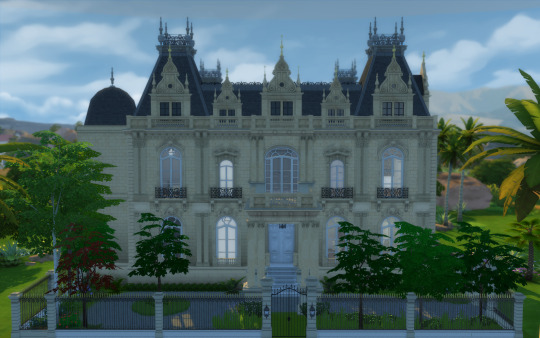
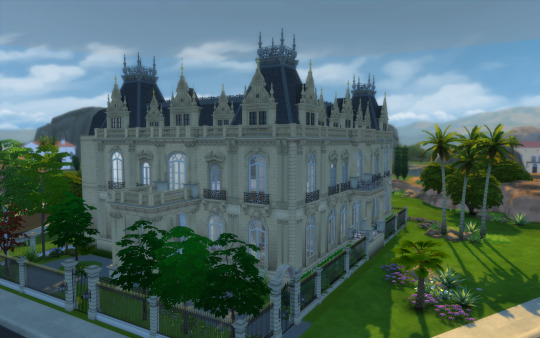


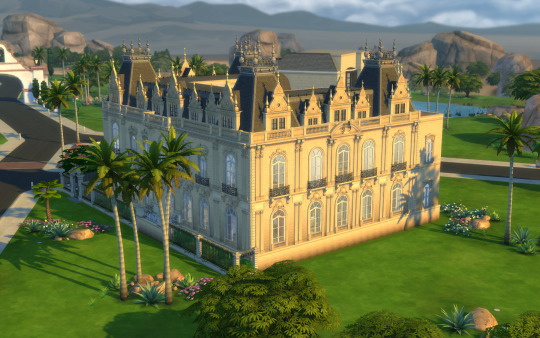

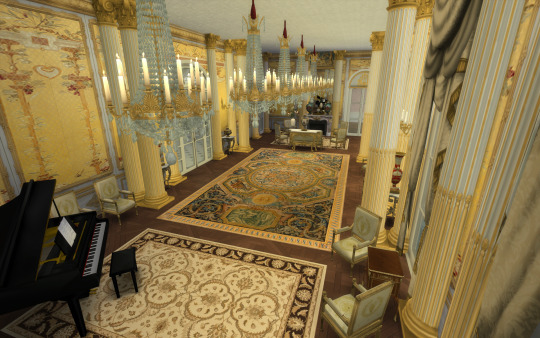

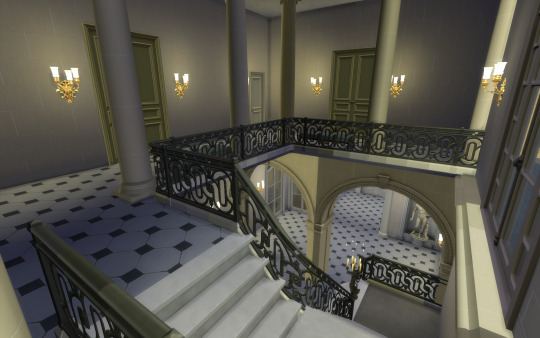

Ortiz Basualdo Anchorena Palace
Hi Guys! I leave this residence here. Could not find the floorplan, so I took some building liberties.
As always, you will need lots of CC for it to work properly, mostly from Felixandre, TheJim, SYB, Aggresivve Kitty, among others.
Thanks to my patreons for all the support! I really appreciate your participation and gives me a boost of confidence!
Please let me know if you like it :)
Enjoy!
DOWNLOAD: https://www.patreon.com/posts/81865201
--------------------------------------------------------------------------------------
A little bit of context and history:
The disappeared Ortiz Basualdo Anchorena Palace (better known as the Ortiz Basualdo Palace) was a luxurious residence that existed facing the San Martin Plaza in the neighborhood of Retiro, Buenos Aires.
This grand mansion, which occupied half a block bounded by Basavilbaso, Maipú, and Arenales streets, was designed by Belgian architect Jules Dormal at the request of Mrs. Magdalena Dorrego de Ortiz Basualdo (1826-1905) for her eldest daughter, Inés Ortiz Basualdo (1853-1922), widow of Estanislao Peña y Lezica, and her youngest son, Carlos Ortiz Basualdo (1863-1910) married to Matilde de Anchorena Castellanos, all members of important aristocratic families of late 19th century Argentina.
The mansion was completed in 1904, and that year, the Municipality of Buenos Aires awarded it the First Prize for Best Façade in its annual competition. This palace should not be confused with the one built in 1912 for Daniel Ortiz Basualdo (1860-1935), the second son of Mrs. Dorrego de Ortiz Basualdo, married to Mercedes Zapiola, at the corner of Cerrito and Avenida Alvear, now the Embassy of France.
The Ortiz Basualdo Palace, which appeared as a single unit, actually contained two important adjacent but independent residences. One with an entrance at Arenales 733, with a grand porte cochère, was that of Inés Ortiz Basualdo de Peña, who, already a widow, moved into it with her daughter Elisa Peña de Uribelarrea (1878-1943), newly married to Manuel Adrián de Uribelarrea Anchorena, a marriage that had ten children. In 1943, Elisa Peña de Uribelarrea died, already a widow, and the executor of the estate entered into negotiations to sell her part of the palace to the Russian embassy, which finally bought the house of Celedonio Pereda on Rodriguez Peña street.
The other great residence with an entrance at Maipú 1210 was that of Carlos Ortiz Basualdo, married to Matilde de Anchorena Castellanos in 1896. Carlos Ortiz Basualdo died in 1910, after having five children, four boys and one girl. Matilde de Anchorena Castellanos married François Verstraeten Dunois in 1914, with whom she had a son and a daughter. Her son, Francisco Verstraeten de Anchorena, married Raquel Terán Etchecopar in 1942, and her daughter, Elena Verstraeten de Anchorena, married Enrique Ibarguren in 1941. The Verstraeten Anchorena family lived in the palace until their last days. After the death of Doña Matilde de Anchorena Castellanos de Verstraeten in 1969, the remaining part of the palace was auctioned and demolished.
The Ortiz Basualdo Palace was one of the most important examples of the palaces and mansions that emerged in the early 20th century in the neighborhoods of Retiro, Recoleta, and Palermo. These mansions were clustered around the San Martin Plaza, along Avenida Alvear and adjacent streets. Until the crisis of 1930, family successions and the emergence of rationalism in architecture definitively put an end to them, both in aesthetic exhaustion and economic reality.
Credit:
Argentina de Antaño
#sims 4 screenshots#sims 4 architecture#sims4palace#the sims cc#sims 4 build#sims4#sims4living#sims4play#sims4royalty#sims4frencharchitecture#sims 4 building#french architecture#argentina_lost_history#palaciossims4#sims4palacios#sims4mansions
26 notes
·
View notes
Text


TEXAS CHILI (1910)
You might call me crazy, but I decided to make a piping hot Tasting History recipe during one of the hottest weeks of the year. That recipe is for Texas Chili, published by the Gebhardt Chili Company in their 1910 cookbook, Mexican Cooking: The Flavor of the 20th Century. Early versions of chili were made up of meat that had been fried in fat and stewed with roasted, dried, ground up chili peppers, not far off from this recipe. While its origins are debated, most sources lead to chili stemming from what is now Texas, but was at the time part of Mexico. While many versions of chili today have many ingredients - beans, corn, etc. - the original was very simple: just meat fried in its own fat and ground up chili peppers. This Tasting History recipe, while using similar ingredients, specifically uses Gebhardt's Chili Powder, one of the early companies which created a pre-ground chili powder (which also contained garlic and other spices). In the late 19th and early 20th centuries, around the time this recipe was published by Gebhardt's, the Chili Queens of San Antonio would bring huge pots of chili to the plazas of San Antonio, heat them up over mesquite fires, and serve up piping hot bowls of chili while dancers and musicians entertained the patrons. Sounds delightful! I decided to make this dish for a unique reason: I developed an allergy to red tomatoes when I was a teen, and have been chasing a good non-tomato chili recipe ever since. What luck, that the original chili recipes didn't contain tomatoes! So, I am especially excited for this Texas Chili. See Max’s video on how to make the dish here or see the ingredients and process at the end of this post, sourced from his website.
My experience making it:
I did have to make a few changes to the ingredients, unfortunately. I couldn't find tallow anywhere, so I used lard in its place (I read online that they have similar smoke points and savoury flavour). Most crucially, I couldn't find anywhere to buy basic chili powder in my area of Germany, nevermind Gebhardt's Chili Powder (which is still sold in the US today, apparently). Strangely, Gebhardt was a German immigrant to the US, but in present-day Germany (at least in my area), it was impossible to find a chili powder that would taste similar to an American one. There were chili flakes, dried chilis, and sweet paprika (the favourite spice of the Germans), but no chili powder to be found. I settled on making my own version of Gebhardt's chili powder using 'Paprika rosenscharf' as my base. I mixed 2 tablespoons of this with 1/2 tablespoon garlic powder and 1/2 tablespoon cumin (the garlic is listed as an ingredient by Gebhardt, but so is 'Spices', so I used cumin for that part). I ended with a pretty good stand-in for chili powder - it smelled and tasted right. For the beef, I used pre-chopped goulash beef to make my life a little easier.
I mixed the beef and lard (tallow replacement), then seasoned with salt. I melted more lard in my pot, fried the onions until a little crisp, then added the beef. I stirred quite constantly, for fear of burning the beef. Like Max said, the amount of lard bubbling in the pot was pretty impressive, and slightly worrisome for my health, but it did eventually boil down after 45 minutes or so. When the beef started to dry up a bit and as it began sticking to the bottom of the pan a bit, I added the water and my makeshift chili powder; the dish immediately turned a brilliant red. At this point, I had forgotten to chop the garlic, so I did so as fast as I could and threw it in. Luckily, the simmer time was so long for the beef to turn tender that the garlic still got a proper chance to flavour the dish. It simmered for just over an hour, and I did stir it once in a while to make sure nothing caked onto the bottom of the pan. I still am not entirely sure how it thickened, but it did somehow! I was surprised by this, because Max's version looked thinner. I served up two hot bowls for my husband and I, accompanied by a side salad and a bit of bread for dipping.
My experience tasting it:
My first spoonful was so lovely and flavourful, and the beef was nice and tender, not chewy at all. I could taste the faint onion and garlic flavours, but the chili powder was really front and centre. There was definitely a decent amount of spice to it (at least compared to Max's), but I think this could have been due to my improvised chili powder's spice ratio. The chili was thicker than I expected, but this made for great dipping with the bread. Both my husband and I cleaned our bowls completely, so this Texas Chili was definitely a hit. I do wonder if that had to do with the amount of lard in it, but I prefer not to think about that part, if I'm honest. I had hoped there would be leftovers I could leave in the fridge overnight in order for the flavours to intensify and give us another delicious dinner the following day, but nope: we ate the entire pot! I would definitely make this recipe again despite its long cook time. However, due to the amount of lard in it, I would only make it once in a while, as a special treat. I think there are so many ways to customize this recipe, either by adding beans, corn, or other vegetables, or by adding a couple extra spices for a change. Chili is a simple and hearty dish, but part of its charm is in how many variations there are. Going forward, I might just make this my base recipe for (tomato-free!) chili that I will change up a little each time I make it. Maybe one day, someone will call me a Chili Queen, too! If you end up making this dish, if you liked it, or if you changed anything from the original recipe, do let me know!
Texas Chili original recipe (1910)
Sourced from Mexican Cooking: The Flavor of the 20th Century by Gebhardt Chili Company, 1910.
Cut two pounds of beef into one-half inch squares, add about two ounces chopped tallow, then salt it. Use a high pot (granite-ware is best), heat in this pot two tablespoonsful of lard; add to this a small-sized chopped onion; when the onion is about half done, add the meat; stir well until the meat is separated and white, then let steam or parboil (with cover off) over a rather hot fire, stirring frequently until the juice of the meat is boiled down, and when it starts to fry add about one and one-half pints of hot water, three tablespoonsful of Gebhardt’s Eagle Chili Powder and a few buttons of chopped garlic; stir well and simmer until meat is tender.
Modern Recipe
Based on Mexican Cooking: The Flavor of the 20th Century by Gebhardt Chili Company (1910) and Max Miller’s version in his Tasting History video.
Ingredients:
2 lbs (1 kg) beef
2 teaspoons (12 g) salt
1/4 cup (55 g) tallow
2 tablespoons (30 g) lard
1 cup (142 g) onion, minced
3 cups (700 ml) hot water
3 tablespoons (25 g) chili powder, Gebhardt’s Eagle Chili Powder for extra authenticity
2 tablespoons (28 g) minced garlic
Method:
Chop the meat into small cubes, about 1/2 inch.
Mix the beef and the tallow together, then add the salt and mix.
Melt the lard in a pot over medium heat and add the onions. Cook for 5 minutes, stirring so they don’t burn.
Add the meat mixture and cook, turning the meat frequently. Once all the meat has some color, continue to cook stirring every few minutes.
Once the juices have cooked off and the meat is left frying in the fat, add the hot water. Make sure the water is very hot, almost boiling. Add the chili powder and garlic and stir until everything is mixed well.
Bring the pot to a boil, then lower the heat and simmer with the lid off for 1 to 1 ½ hours. The time will depend on the heat and the cut of meat you’re using. Mine took an hour for the meat to get nice and tender. You shouldn’t have to add any more water, but keep an eye on it because if the water all boils away, the chili will burn.
After the chili has simmered and the meat is tender, serve it forth and transport yourself back to the plazas of San Antonio when the Chili Queens reigned.
#chili#max miller#tasting history#tasting history with max miller#cooking#keepers#historical cooking#20th century#americas#american recipes#beef#meat#spicy food#Mexico#mexican food#Texas#Mexican Cooking: The Flavor of the 20th Century#Gebhardt Chili Company#new world#stews
2 notes
·
View notes
Text


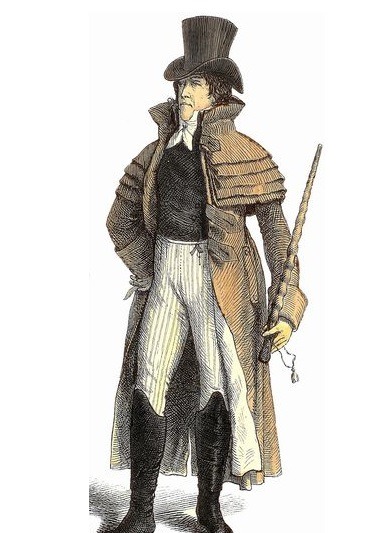



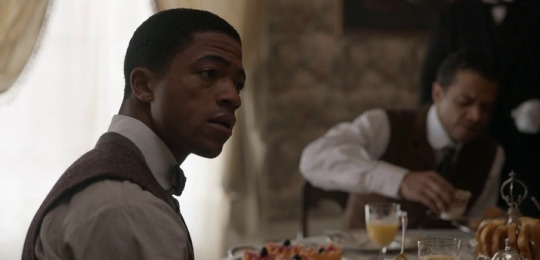
What year is Lestat from? (or when did he take his dirt nap)
Before we learned about his backstory, his pre-Louis makeover outfits give us some clues. In his first appearance on screen, he is wearing some kind of a Garrick or Carrick coat, a multi-layered caped coat generally assumed to be a fashion started by the military that was eventually adopted by civilians as riding or travel wear, which indicates Lestat has likely just arrived from Europe. These coats were popular throughout the regency and up to the mid-19th century.
He's also wearing a cravat, which distinguishes him from the other male characters who are either in ties or bowties (see Louis and Paul). Cravats were still around in 1910 although definitely out of fashion and more likely to be worn by an older gentleman. They were still fairly popular into the 1860s-70s (see photo on the left) but eventually faded as ties and bowties increased in popularity in the late 19th century and were the norm by the early 20th century (photo on right).
In episode 6 he mentions playing the 1878 chess champion (Johannes Zuckefort) in the Jardins de Luxembourg. Its important to remember that fashion changed quite slowly until the 20th century when trends started updating drastically decade to decade so there is a wide range of decades someone dressed like Lestat could've easily fit in.
#iwtv#btw the coat louis wears in ep2 when he's learning to hunt is an ulster#that could be either his or lestat's tho#that kind of coat was still worn into the 20th century but was intro'd in 1860s-ish#costume analysis
85 notes
·
View notes
Text
This May 17, 2024 article was really interesting (and doesn't seem to be behind a paywall). It covers the relationship between anarchic ideologies and the accessibility of dynamite and how together they unwittingly led to the modern surveillance state.
While this article is mostly focused on anarchic terrorism in the U.S., it does mention Émile Henry, the French anarchist whose 1894 trial and execution were covered by Gaston Leroux for Le Matin (130 years ago just yesterday). I've mentioned in other posts that Henry's heated words at trial likely served as inspiration for Erik's wild description of his own plot to bomb the Palais Garnier, a pivotal plot point of The Phantom of the Opera.
Part of understanding why Leroux wrote Erik the way he did lies in understanding the nature of anarchic terrorism of the late 19th and early 20th century. In 1910, the idea that an anarchist might want to blow up the Garnier wouldn't really have been so surprising. The Liceu Opera in Barcelona was even bombed in 1893. So what was Leroux trying to say about his own society in giving his monstrous Erik anarchist tendencies and then asking us to pity him in the end?
In reading about anarchy and anarchic terrorism, I was struck by how common bombings and assassinations were during this time period in both Europe and the U.S. And how little we talk about them now. Many high ranking people were assassinated by anarchists: Empress Sisi, the president of France, of the U.S., Franz Ferdinand, kicking off World War I. One hundred years ago, if a bomb went off in New York City, most people would assume an anarchist had planted it. Our assumptions would be very different today.
Being an article about terrorism and bombs, it isn't particularly sympathetic to anarchists. But I did find this a interesting explanation for their actions:
"One side believed it was entirely appropriate to open fire on striking workers with machine guns and burn their tent cities to the ground, as Rockefeller forces did at Ludlow; the other side believed that the correct course for society was to eliminate all corporations and governments and return to the small-scale guild systems of Renaissance Europe, and that the best way to advocate for that vision was through a campaign of mass terror and targeted assassinations. From the anarchist’s perspective, the true infernal machine that had been unleashed was James Watt’s steam engine. Horrifying workplace accidents were simply the cost of doing business. The industrialists had been blowing people up or dismembering them long before the anarchists launched their counterattacks." By Steven Johnson, author of “The Infernal Machine: A True Story of Dynamite, Terror and the Rise of the Modern Detective,” from which this article was adapted.
3 notes
·
View notes
Text
The modern girl of the early 20th century
In this article, we are going to discuss the way in which art, comics and illustrations in the early years of the 20th century helped shape and cement the archetype of the new modern woman, not only in the western world but globally. After all, modernity happened everywhere. I don’t like to put countries and rank them as one set of countries as being the end goal that everyone else is trying to catch up to, because this is very much a tenet of imperialism and i am decidedly not here for it. However, there is no going around how this is part of a very prevalent narrative. That you can quantify progress and quote unquote civilization and modernity. I think of the prevalent idea about of how progress moves and how it’s a view that is generally associated with the current capitalistic understand of our world that values constant progress and growth, and that history works in that manner. However progress is never truly linear, and the way history evolves is full of ebbs and flows, of progress in certain areas, and regression in others, and there is always a judgement of value that is being made when thinking about the march of progress . The 1920s and the 1930s were an era of constant change on all fronts, and the world as a whole was marching straight into the modern world as the repercussions of the first world war were still being felt.
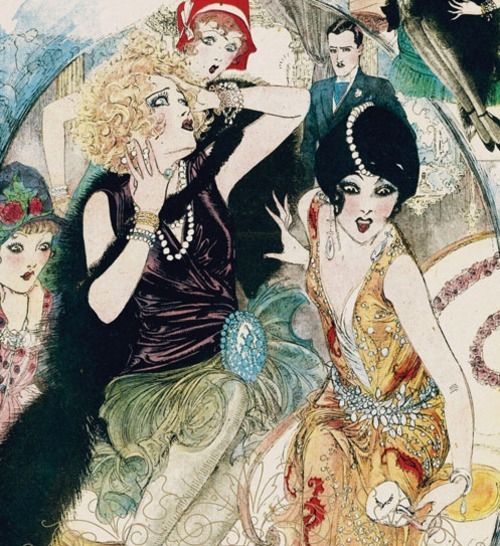
In those years, the printed medium was at its peak, illustrated strips, which were what we would consider to be the ancestor of the comic were gracing the pages of newspapers , and in an age with no internet, where the medium of radio or movies were just getting their start, newspapers were the main way people got all of their informations on the current events, the latest plays and the latest books and all of the knowledge about the right places to be if you were anyone. From the classified ads to the marriage announcements, the newspaper and the printed medium in general was solidly embedded in the culture.
The 1920s and the 1930s were the beginning of the movement of art deco, a new modern style that was clean and streamlined visually, with very neat and geometrical lines, and it is very much a reflection of the current trends in fashion, architecture and design. It is very much in the spirit of the times and i think it was very much in keeping with the times where there was much more of a monoculture in general, you could easily pinpoint what were the big lines of the trends of the eras as they all played off each other and reflected the world that existed around them — through the visual arts, art and culture. There was a generalized aesthetic, if one can say it like that, in a way that I don't think we have anymore. I mean i have been trying to pinpoint what are the trends for the 2020s and when I tell you I absolutely cannot. I have to admit that trends are cycling at such a fast rate nowadays that they do not really have the time to truly permeate the general mainstream culture. On one hand, I do think it’s good that no one can feel the pressure to ascribe to a specific mainstream set of trends if they don’t like to, I think it’s way better to really be able to pick and choose what kind of style truly reflects the person you are and your interests, however I think this does imply a minimum of effort to truly try and discover those interests and curate a personal style and not follow the extremely fast trends that we have now. While before, those trends shifted on a cycle of roughly 10 years, and no matter how stark the transition from the 1910s and the Edwardian era to the shapeless and shorter dresses of the 1920s and then to the more feminine and elegant silhouette of the 1930s, the truth is that the change is very gradual, the shape relaxed and shortened season after season, and it’s only with distance that you can perceive how strong the change was. I think so much of it is in hindsight. Maybe in 10 or 20 years I will be able to pinpoint the changes and broad line of the 2020s tendencies, because history aways seems clearer when you are removed from it.
Through art, images, fashion and advertisement, the world saw a changing and mutating definition and significance off what it meant to be a woman. First of all, I think I really have to stress that i’m talking in binary terms here because this is how the illustrations and advertising as well the shifting of the gender politics were at their base core. I totally acknowledge how it is so much more complicated than that, and the definitions of womanhood and femininity are as diverse and complex and Complicated as there are women in the world, and that our relationship to gender and gender expression is an ever evolving one and that understanding will always be within a certain societal context and you cannot divorce that understanding from the global realities. All of it is arbitrary in a certain way, but it is constructed with social interaction, customs, and visual images contribute greatly to this understanding that we have of it. I will be taking about a very mainstream view of gender, and womanhood here through advertisements and images, which is how that identity was constructed during the period we’re talking about, and especially during the interwar period which was one of great change and shaking up the old ways of how things were being done and how people reacted to it, as well as how it translated to the world of visual culture specifically in the area of the illustrations and comics that were in the printed press and the advertisements of the era.
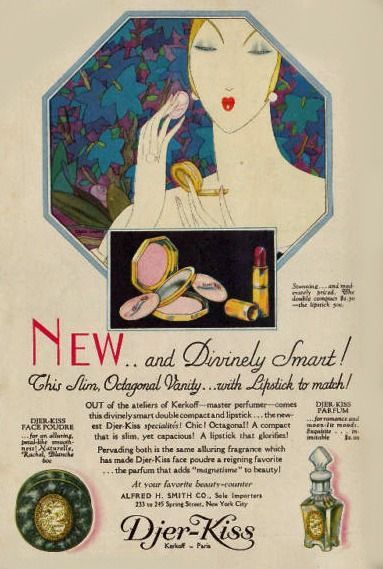
During the 1920s, we can see that change very quickly and assist to a boom in consumerism, with the roaring twenties, the end of the first world war and the end of a very specific idea of traditionalism, there is this new and unbridled world of possibilities in the general culture and consciousness. The youth goes out to try and have fun, the magazines and stores are trying to sell anything and everything to a new modern young woman. The 1920s is the moment where we can see that shift, it’s that clinching moment where things become overwhelmingly mass produced and the predominance of the ready made. Not that this shift was not happening beforehand, the industrial revolution happened in the 1830s or so and it steadily continued during the 19th century, building over what was existing, and changing the cultural mores and the habits around consumption, but i think that break in the 1920s is absolutely obvious. It is the beginning of modernity as one calls it.
With the advent of modernity came new possibilities and understandings. Of course, this phenomenon doesn’t decline itself the same way everywhere in the world, the context in India will be very different from the society in Japan or in the United Kingdom or in France, however, it is possible to see a significant shift in the understanding of the concept in itself of womanhood, and this happened throughout the whole world. In a matter of a couple of decades, the way a woman existed had shifted to something new, exciting, and even a bit scary to those from an older generation holding on to their own definition of what a woman should be. It was the age of the flapper, a word that came to designate this very specific archetype of independent young women of the 1920s.
The early 20th century was an era that was moving extremely fast in terms of the illustrated press. From articles and illustrated strips to publicity, the image was more present than ever before. During the last season of the podcast, I talked about the Golden Age of Illustrations which was from the 1870s to the 1920s, and the reason for this truly that it was the last years before the use of photography and video truly took over the use of illustration in the mainstream for entertainment and advertisement.
These were also the years where cinema was making its way, the silent era, the beginning of the way we think about celebrity. It truly changed the game in a way no one could have predicted. It was an age of glamour and excess. The early years of the film industry were absolutely insane, and please tell me on twitter or instagram if you would like a more in-depth foray into that subject and more precisely into the visuals, the art directing and the way the movies of that time looked, but suffice it to say that it was absolutely bonkers, Hollywood was so unhinged. There was glamour, beauty, but also murder and scandals and sin, and all of it being filmed in a soft focus of satin and sin. Even back then, as Hollywood’s myth and legend was being constructed, it was a place where you could gain it all, or you could lose it all, it had the appearance of perfection, and yet, everyone talked about how it was a den of sin and vices. And I will say that the current Hollywood does not compare at all to those golden years, and especially not when you think of it in terms of the dream that Hollywood sells. All of the current players in the Hollywood scene bore me to tears, I am not enchanted by people trying their best to be hashtag relatable in their gigantic mansions and white tees and cargo shirts. I genuinely think that if you are rich, you should at least look the part somewhat, otherwise what is the point of it ? Where are the beautiful glamorous people at ? No one is even doing a scandal the way they used to anymore, it truly is tragic.
Ralph Barton, a popular illustrator of the 1910s and 1920s created his illustrations for the book Gentlemen Prefer Blondes written by Anita Loos in 1925. His art was a beautiful complement to the story and underlined perfectly the fun and comedic story of the way the young women were trying to climb the social ladder. That book was adapted brilliantly later in the 1950s and starred an absolutely brilliant Marilyn Monroe in the titular role of Lorelei Lee, and while the 1950s movie truly captured the heart of the story and made it their own, which just goes to show that an adaptation does not have to be completely faithful to the text to be faithful to the core of the story. But the original book was about the flapper and the gold digger and the new kind of woman that was started to rise in that era She was a social climber, desperate, and yet still fun and irreverent. The illustrations Barton created for this book were fun, fresh and very representative of the energy of that era, where there was a lot of social mobility, and people were making fortunes, looking to make fortunes, or simply losing these fortunes. It was simply an era of social upheaval in a lot of ways. It was in the air du temps.


This era was chock-full of illustrators and talented artists as visual arts was still extremely highly valued in the mainstream, a lot of female illustrators getting their names in the papers and becoming well known for their comic strips and illustration work. The visual of the modern girl or the new woman, both terms being used almost interchangeably and describing the same concept of this new type of women at the dawn of the jazz age was developed by these very artists. She had boldness, charm and a sort of sexual awareness and a fearlessness, with a desire to seize life and all its possibilities. A Sort of nihilism in line with the general sense of dread and celebration that often follows consequential world events, even a bit of a hedonism especially in western countries. After the first world war, a break from the past and toward modernity.
The short bobbed hair, the vamp makeup, the receding hemlines, even though the length of their dresses were still fairly modest by today’s standards, after all, their knees were still covered, it was such a scandalous break from the earlier traditional mode of dress, may it be the western Edwardian dress, or the places where dress was still majorly traditional and cultural outfits. After all, it is because of capitalism, fast fashion and cultural imperialism and globalization that nowadays we are all wearing very similar fashion and dress whether you live in Italy, Nigeria or Peru. Of course, cultural mores will make it be slightly different from place to place, but hoodies, trousers trainers are worn all over he world. However. A bit more than a hundred years ago, people were still wearing their caracos and djellabas in Algiers, and now those outfits are being left for special events. In Korea, Hanboks were worn on a daily basis. In less than a hundred years, most of, if not all, traditional and cultural outfits have been relegated to relics of the past. And yet, the 1920s is that moment where modern western dress started to really become the norm as the world shifted into modernity, and this new scary idea of the modern woman started to take hold.
Beauty and the advertisement of beauty, makeup and fashions were a cornerstone of the way that identity was constructed, because for the first time since the 18th century at least in the western world, the use of visible makeup was no longer frowned upon. I say visible, because even though makeup was thought to be the purview of actresses and ladies of ill-repute in the 19th century and the Edwardian eras, women were still using cosmetic aids to beautify themselves. Of course, it's the ever-present no makeup makeup look that is infinitely more complicated to master than any colorful and ostentatious look could ever wish to be. So at the turn of the 1920s, women were wearing dark lips, in plums and dark reds, and surprisingly bright eyeshadows and rouge, and none of it was made to be discrete and hint to the notion of a natural face. The Modern Woman was painted and made-up, unbalancing the social norms that were established until then. It was a very visible shift from the obsolete and the traditional to the very made-up New Woman, and there is a list of beauty and makeup items and objects that are all absolutely gorgeous I have to say, that are associated with this. It’s the new accessibility of consumerism where it was before limited to the elites, now everyone could purchase eyeshadows and a compact of powder and rouge and those minuscule multipurpose makeup compacts with a tiny lipstick and a bit of rouge and powder and some mascara, so that you could touch up on the go and carry it in the tiny bags that were in fashion. Those items were luxurious and opulent, and fairly affordable comparatively to what they had been previously, especially with the rise of the ready-made.
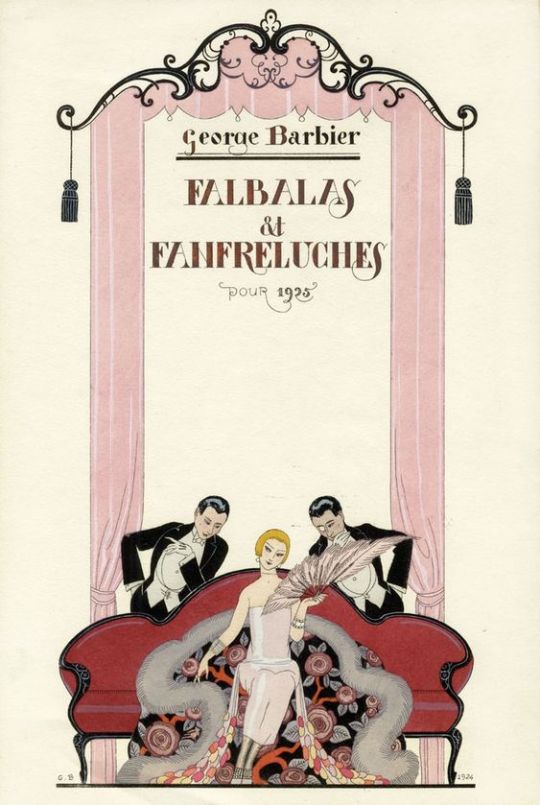
Is consumerism a visual symbol of modernity ? After all, the almost omnipresence of publicity in our visual world, which was definitely the case in the global world in the 1920s, is one of the ways in which that modernity, along with the dominion of capitalism that demands constant consumption from the people. As John Berger says in his foundational art history book Ways of Seeing published in 1972, which btw I totally recommend to get if you want to dive a bit deeper into art history theory, or you can just watch his 4 parts show of the same title which btw and i haven't said anything COULD potentially be on youtube but i haven't said anything at all. Anyway as he says quote : publicity images […| belong to the moment in the sense that they must be continually renewed and made up-to-date. Yet they never speak of the present. Often they refer to the past and always they speak of the future unquote. This was extremely relevant in the world of the interwar, where the construction in itself of the identity of the modern woman was made through those publicity images.
There is also something to be said about how the concept of modernity and of the modern girl truly blurs the lines of a social hierarchy., and that was a good thing, I do think those lines should be blurred to the point of non-existence. Now everyone could look like the popular starlets of the movies and buy their own makeup and clothes that could make them look as glamorous as the women on the silver screen, the easy availability of cosmetics, and of a climate of consumerism made it so that everyone could attain that status, the lines between the social boundaries and between the quote unquote elites and the working class are becoming more fluid than ever. Where the way you dressed immediately signaled your social rank and your place within the hierarchal structure, which, in turn, told other people how to treat you, this was no longer necessarily the case. However as those lines are shifting and moving, the way you could signal your status have also shifted.
The year was 1925 and Nell Brinkley, a young reporter and famous illustrator, was sending the first strips of The Adventures of Miss Prudence Prim out for publication to William Randolph Hearst’s Sunday American Weekly. Her stories of romance, love and carefree amusement were capturing the zeitgeist of this period that was the interwar: these years full of change and when modernity was at the forefront of culture. Born in the small town of Edgewater in Colorado in 1886, Nell Brinkley always had dreams of making art her career. At only 19 years old, after convincing her father that she could earn her life with a short contract as an illustrator at the Denver Post, she finally moved to the city where she would accomplish those dreams : New York. She came of age during the pinnacle of Edwardian sensibilities and was influenced by the ornate curves of Art Nouveau, but also by the new visual ideas of Art Deco. She created a style that was very unique for her time and was a woman who was constantly looking forward to the future. She was a perfect example of the New Woman of the 20th century. A woman that was bold, vibrant and who was not afraid to speak her mind. Her art was a vignette of a time that's now long gone by, and yet her art still feels as charming as it used to be. Those were delightful images of youthful fun and desire, ideas of romance, and, most surprisingly perhaps, issues of women’s rights and the working class.
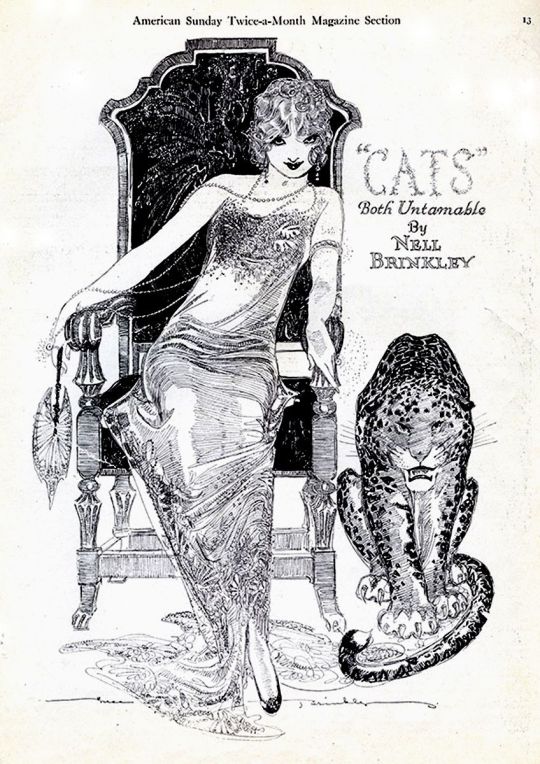
Brinkley got her start and her renown as an illustrator and journalist in 1907, while covering the gruesome and shocking case of Harry K. Thaw, a highly publicized trial involving the beautiful and popular showgirl Evelyn Nesbit. This case was sordid, involving a murder, a jealous husband, and a previous lover of Nesbit, and was a huge news story during that year. Brinkley’s interviews and various portraits of Nesbit put her in the limelight as a talented illustrator and reporter.
Commentator and columnist as well as an artist, the career of Nell Brinkley was prosperous and she was a constructing a new vision of womanhood. She was writing and drawing for women, and they were her direct audience. She wrote about cultural events, reviewed plays, gossiped about the latest fashions and movies. Her columns and her art were a guide to living fully and encouraging women to realize their full potential. Brinkley’s work had a definite feminist slant to it, in favor of working women and pushing for the rights of women. Her cartoons and illustrations had a decidedly political element to them that was part of the spirit of the times, about the endless possibilities that they carried within them. Without necessarily being an activist, she was always pushing for progress and women’s rights and trying to unshackle the constrictions of gender norms that were remnants of a previous generation. She was a writer as well as an illustrator, and this is how she communicated a vision of womanhood that was new and fresh, and she represented the way a lot of young women felt during these years. The New Woman, as she became known, was the face of a modern generation of women.
The archetypes of her illustrations were so strong that they were known as the "Brinkley Girls, » with their head full of short curls, their sleepy eyes and their darkened lips which brought a new vision of femininity. The Brinkley Girl was a break from traditional archetypes of beauty. She was no longer the demure and aloof women drawn by Charles D. Gibson that were in vogue. The Gibson Girl of the Edwardian era, with her long hair, her cold and distant beauty was now a thing of the past. The Brinkley Girls were far from being shy, and were not hesitant to take life as it came, and live fully and wholeheartedly. There was a certain desire of enjoying one’s life that was at the core of the illustrations of Brinkley. Emotion, passion and romance, as well as a sort of carefree independence were the new motto of a new generation of women who wanted to desperately have fun. It was an idealized idea of life and romance that provided a definite appeal to its audience.
The Brinkley Girl archetype was so widespread that it was used for advertising during the 1910s and the 1920s for diverse products that the modern woman would be using in her daily life. She was thus set as a symbol of the eminently modern woman. From hair curlers that « will not break your hair » to henna dye and face powder, the curly haired young women of Nell Brinkley were a good example of how illustration was used as part of advertisement in the early 20th century, blurring the lines between art and capitalism. The Brinkley Girl was known in the cultural sphere as being a symbol of a new generation of young women who were fearless, representing a vision of womanhood that was progressive and a celebration of independence as well as pleasure.
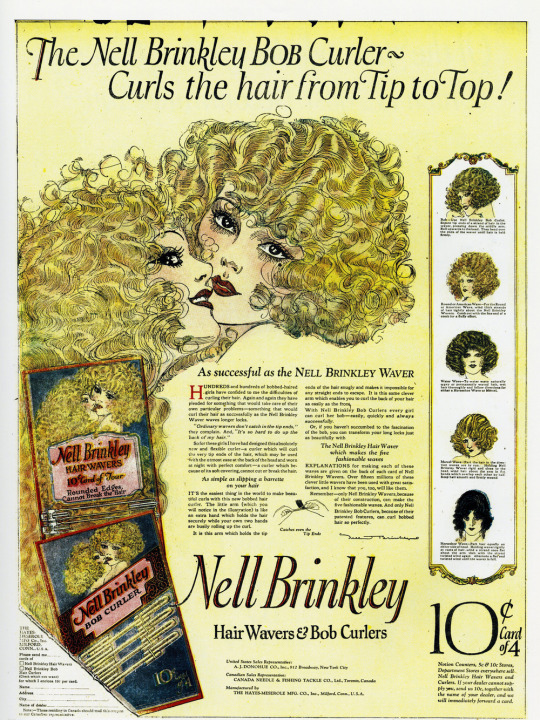
In the 1920s, her art involved sequential images and interesting stories, all starring young women as the main protagonists and centering their point of view. Starting with her serials in the 1910s and steadily creating comics during the rest of her career, she was an incredibly prolific author. From 1918 and onwards, most of her comics were full page and full color, a privilege reserved for very few artists during those years.
The Adventures of Prudence Prim, written by Carolyn Wells and illustrated by Brinkley, follows the life of a young lady who lives with her two sensible Edwardian aunts, and who has dreams of romance and adventures. Prudence takes the opportunity of her aunts taking a nap to go out and experiencing life for herself, after all « now if I just sit still and do exactly as I ought - I’ll never get a thrill ! » And so the adventures of Miss Pruddy Prim begin ! They are told each Sunday as she lives through new experiences and goes out and wears glamorous and fantastical ensembles. The pages are peppered with the different characters that Prudence Prim meets during her adventures, from society ladies with beautiful clothes and bobbed hair to dashing suitors who sweep her off her feet. Brinkley truly takes the time to dress all of her characters in fanciful outfits to match the universe she creates. The story is told by small, witty verses with a lot of good humor. Those narratives capture a certain desire for escape and the new daring sensibilities of young women, of their hunger for love and life. It is complete with the details of the latest fashion and decorated with illustrations of roses which will eventually influence the style of shoujo manga in the 1970s, with its abundance of roses, the drama, and extravagance of feelings.
The art of Brinkley creates a very indulgent feminine universe, where the men are dashing and noble, but still drawn in a very feminine way. It is in line with the slight gender fluidity of the time, where men were more delicate and women were cutting their hair short. Nonetheless, her worlds were utterly feminine and yet were trying to change what this world meant for the young woman of the interwar period — to leave the past behind and move toward the future and document the rapid changing social norms for women. Her style is especially striking in its transitional quality between art — the heavily ornamented and rounded lines of the Art Nouveau years in which she came of age and the streamlined and fashionable lines of Art Déco. It is a style that found a lot of admirers, but also a lot of detractors. She truly made her signature style one that captured the new woman of the era. She captured a very specific moment in time and the way women might have understood themselves. This understanding was not universal, however it captured the way American women wanted to visualize themselves. The way they wanted to represent and depict their future. It was an ideation that was becoming reality. In a way, Brinkley was creating the future through her art. Of course, she was not the only one. She was simply part of a moment in time, but I do have to say that Brinkley, with her frothy pictures and her fanciful curves was successful in a way a lot of artists were not.

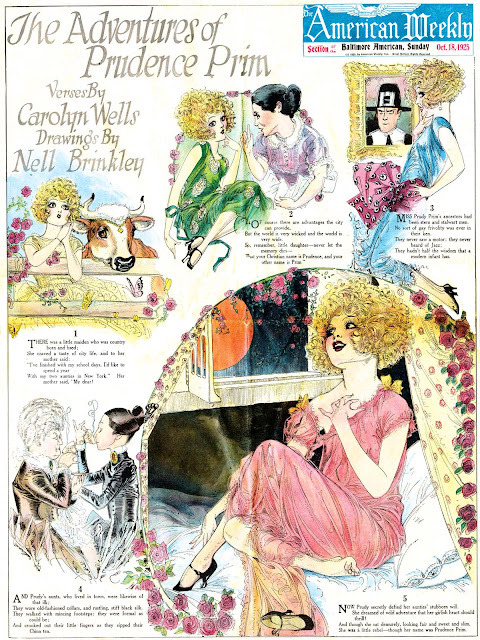
To me, she represents a very feminine idea, and to me, this type of art often receives criticism simply for daring to be feminine, maybe a bit shallow, maybe a bit superficial, but after all very cute and very fun. The rococo genre of the 18th century received similar criticisms in my opinion for being sugary and cute and overtly feminine. And this is simply always an unfair criticism to me, because judging something being aligned with femininity negatively comparatively to something more masculine is just plain old sexism. It’s not that the genre of rococo is devoid of criticism, there can be much to criticize, but people mostly bring up the fact that its frilly and pink and for some reason, that means it is not a sign of serious art. After all, this is what the neoclassical movement that followed was about. Something more visually sober, and more serious in its subject. And once again, the pendulum of taste swings.
Nell Brinkley was interesting as an artist that had this idea of the new woman being at the center of all the work she was doing. She was active during an era of profound change in the way women were perceived and perceived themselves, and whose art was something that was created solely for the modern woman. Brinkley was a daring and brave woman, with a taste for excitement and joy. She did not back down from any challenge; she flew a biplane in 1914, illustrated it, and commented on it for her audience's pleasure:« Nell Brinkley Tastes Joys of Real Freedom Soaring in Clouds ». She had adventures of her own and lived a full and brazen life. She got married to Bruce McRae II in 1920, and then she divorced him. I have to mention that he was several years younger than she was, so she was breaking boundaries in all sorts of ways,
She was a mother but also a career woman, and always followed her heart and ambitions no matter where they took her. Despite knowing a widespread cultural and financial success during her time, Nell Brinkley went the same road as many successful women artists often do, and was subsequently rapidly forgotten by history apart from the niche academics and amateurs of early 20th century comics. What she accomplished was no small feat. She managed to create this pictorial universe that understood the preoccupations of a modern woman, from her leisure to work to romance, from her activism to her frivolities, and how to balance all of it. She was a modern woman through and through.
This archetype of the modern girl is an intrinsic part of national identity and how those identities shaped the way she was understood and the way she was perceived by the general public, not only domestically but also internationally. She was also used for pushing political agendas either as to how the youth, and especially young women, were out of control, and trying to reassert the previous order of things, were women were not going out partying at all hours of days, and were expected to stay home. Or, on the flipside, using those young women living their lives as a political statement about how much more modern and civilized she was compared to the quote unquote retrograde societies and traditions. And this happened not only in the western world, but in Russia, India, China, Japan and elsewhere. From the illustrations and caricatures of Guo Jianying who satirized this new type of modern woman in China, with jokes and piques about the way things were changing, and changing fast, to the ads in various news papers across the world that promised their customers beauty and pleasure.
During the interwar, the illustrated advertisements for the brand Shiseido, a brand that started in 1872 and still is a sizable part of the beauty landscape today, and that revolutionized the market for the modern woman in Japan, were at the intersection of art, design and advertisement. These images were ones that were communicating an idea of modernity and newness, and yet advertised products that helped the consumer access this new ideal and be able to adhere to the beauty standards of the era, that were particular to Japan.

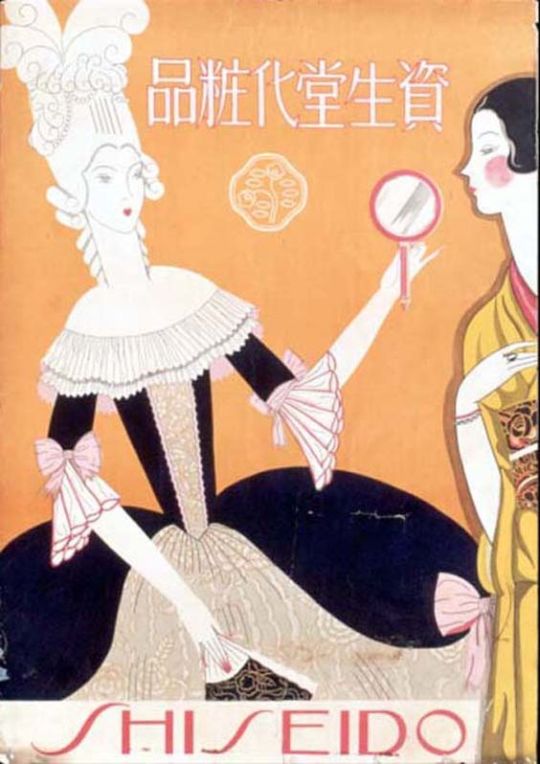
Shiseido’s graphic design communicated an idea of chic elegance that was becoming an aspirational quality during the interwar. The poster design by Sawa Reika in 1927 shows a young blonde woman wearing a fashionable evening dress holding a camelia flower, the brand’s logo, which was designed by Yabe Sue in 1924, all with the streamlined aesthetic conventions of art deco, and a limited palette of colors The result is minimalist and beautiful, and conveys so efficiently this new type of lifestyle and modernity that was being created, all through the use of graphic designs and cosmetics advertisements.
Even though the concept itself the of womanhood during the interwar was a mix of effervescence in the way it developed and grew and changed, and how, it stayed the same in a lot of ways. The illustrations of journals and magazine covers such the covers of the german graphic design journal « die reklame » in 1929 by Albert Rabenbauer were just another way the image of the modern woman got used in the art and the advertisements, not only helping to construct the idea of a modern woman, but the way that cosmopolitanism and the life in the urbane centers, full of the busy bustle of cities is just another way young women could enjoy a certain anonymity and freedom.
The idea of a chic and cosmopolitan world of material goods, of parties, of champagne and music, of a worldly but extremely fun woman at the center of it was one that was dominating the imagination. Ethel hays had small comic illustrations in the papers that satirized and caricatured that specific archetype of the flapper. Her character « Flapper Fanny » was the woman who was fashionable, a bit silly and yet, still very witty. Hays’ illustrations are extremely adorable, and manage to land a joke or a line with only a small drawing. The modern woman, the flapper, the gamine, this idea of the intrepid fashionable new woman was constructing itself in reality and also through the art, the illustrations and the visual representations of her in the advertisements and those, in turn, helped shape the way that the modern woman saw herself. Despite what she represented about this new era, being used to express concepts of modernity, a fear of change when women are going out and gaining those newfound freedom, being bolder and more in touch with their sexualities and their expanding idea of femininity, these women were still people and not only concepts about which people could discourse and debate, and I think this is something that is quite often forgotten.



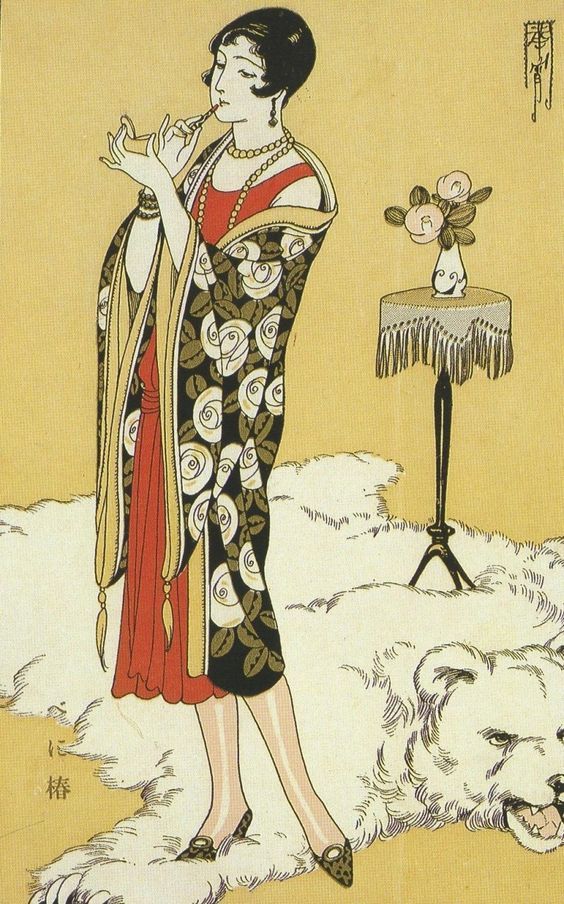

14 notes
·
View notes